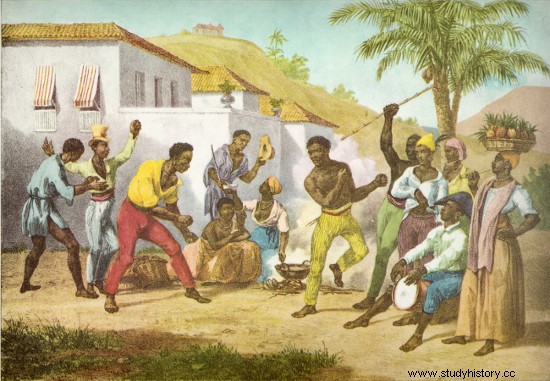
By Tales Pinto
The end of slavery in Brazil for many years was presented as an action of the Brazilian State, pressured by England, through various legislations, culminating in the signing of the Golden Law by Princess Isabel, in 1888. It was also presented as a result of the interests of the coffee landowner elites, who saw wage labor as more profitable than the power of enslaved work.
However, little is said about the role played by the slave struggles as the main form of pressure for the end of slavery . Considering that slavery was the mainstay of Brazilian colonial and imperial society, the slave struggles represented a tendency of internal rupture in this relationship, which at the end of the 19th century could no longer be sustained.
These struggles have existed since the beginning of slavery. The most notorious case during the colonial period was the formation of the Quilombo dos Palmares , in Serra da Barriga, where the state of Alagoas is located today. Several other quilombos were formed, not so large, it is true, but that showed their importance, since after the flight from the farms, the slaves intended to create a break with slavery, seeking freedom.
The escapes, however, did not only occur in cases of rupture with slavery. For the most part, they occurred as a search for improvements within the slavery. This was the case of the flight claims, which intended to demand better working conditions in the area. An example of this was the escape of slaves from Engenho Santana , in the region of Ilhéus, in Bahia. In 1789, a group of slaves fled the mill and formed a quilombo in the vicinity of the farm. They presented their master with a treaty, in which they demanded better working conditions, election of other overseers and the right to “play, have fun, and sing at all times we want without getting in our way or needing permission.” [1] This event demonstrated that the slaves' struggle was for changes in everyday life within the workplace.
Another form of struggle carried out by slaves was rebellions. In Bahia at the beginning of the 19th century, about 30 slave rebellions took place or were plotted, being prevented by police action. The most notorious of these was the Revolt of the Malês, in 1835. Taking into account the Independence of Haiti, which at the beginning of the century was violently led by slaves and resulted in the end of slavery, the uprisings of enslaved Africans created the fear of a repetition of a similar event in Brazil, which could literally cost the farmers their heads.
The establishment of quilombos near cities also contributed to undermining the Brazilian slave system. The creation of solidarity networks close to the quilombos, with inhabitants of the cities (freed slaves, relatives or even with whites), made it possible to carry out small commercial transactions that allowed the material reproduction of their lives in freedom. In addition, there was an approach to free people, creating a feeling of anti-slavery.
Abolitionist legislation also resulted in the intensification of social conflicts between slaves and masters. The intensification of internal trafficking after the Eusébio de Queirós Law , in 1850, took slaves considered “undisciplined” to the farms of the south-central region and who imposed the conditions of “fair captivity” with rhythms and jobs and which jobs they should perform, decided by the slaves.
Contact resulted in mass riots and flight in the decades before abolition. The Law of the Free Womb , of 1871, also led slaves to contest the situation of slavery in which they found themselves. In 1885, 120 slaves from the Cantagalo farm , located in the city of Campinas, in the interior of São Paulo, rebelled and fled en masse from the farm towards the city, chanting “Viva a Liberdade!” along the way.
All these actions created a climate conducive to social upheaval, if they were transformed into larger-scale actions, putting the economic and political power of the Brazilian elite at risk. In this sense, but not denying the other factors, the slave struggles against slavery, conducted autonomously by the slaves, created an internal rupture in the slave system, pressing for its end in 1888.
[1] Note: AMARAL, Sharyse Piroupo do. History of the Negro in Brazil. Brasilia:Ministry of Education. Secretary of Continuing Education, Literacy and Diversity; Salvador:Center for Afro-Oriental Studies, 2011.
